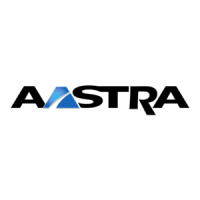Ascotel IntelliGate 2025/2045/2065
68 System Interfaces Part 1
3.2 User-Network Interfaces
The PBX supports digital and analogue user-network interfaces.
3.2.1 Digital user-network interfaces
On each of these digital interfaces several appropriate terminals can be hooked
up and powered simultaneously.
Each of these interfaces has two 64 kbit/s user information channels and one 16
kbit/s control and signalling channel (2B+D). This makes it possible to establish
two independent call or data connections simultaneously.
3.2.1.1 S user-network interface
The S user-network interface is a digital 4-wire interface used for connecting sys-
tem terminals, ISDN terminals, Terminal Adapters and ISDN PC cards. The PC
Operator is connected via a special Terminal Adapter.
International dialling tone [Yes / No] If "Yes", the dialling process is interrupted
after one of 10 predefined digit sequences to
wait for the international dialling tone.
Exchange digit barring [No international dialling tone
or 1…10]
If the trunk line is configured to "Behind PBX"
(analogue down-circuit connection), the
exchange access prefix of the up-circuit PBX
has to be entered in the exchange digit bar-
ring.
Release signal [Yes / No] In most cases the public network sends the
PBX a release signal whenever the external
subscriber ends the call. If the parameter is
configured to "Yes", the connection will be
subsequently cleared down by the PBX (see
also"Clearing down Exchange-to-Exchange
Connections", page 323).
Note: On analogue network interfaces the
only release criterion the PBX recognises is a
loop interruption, not a polarity reversal or
busy tone, etc.
Parameter Parameter value Remarks

